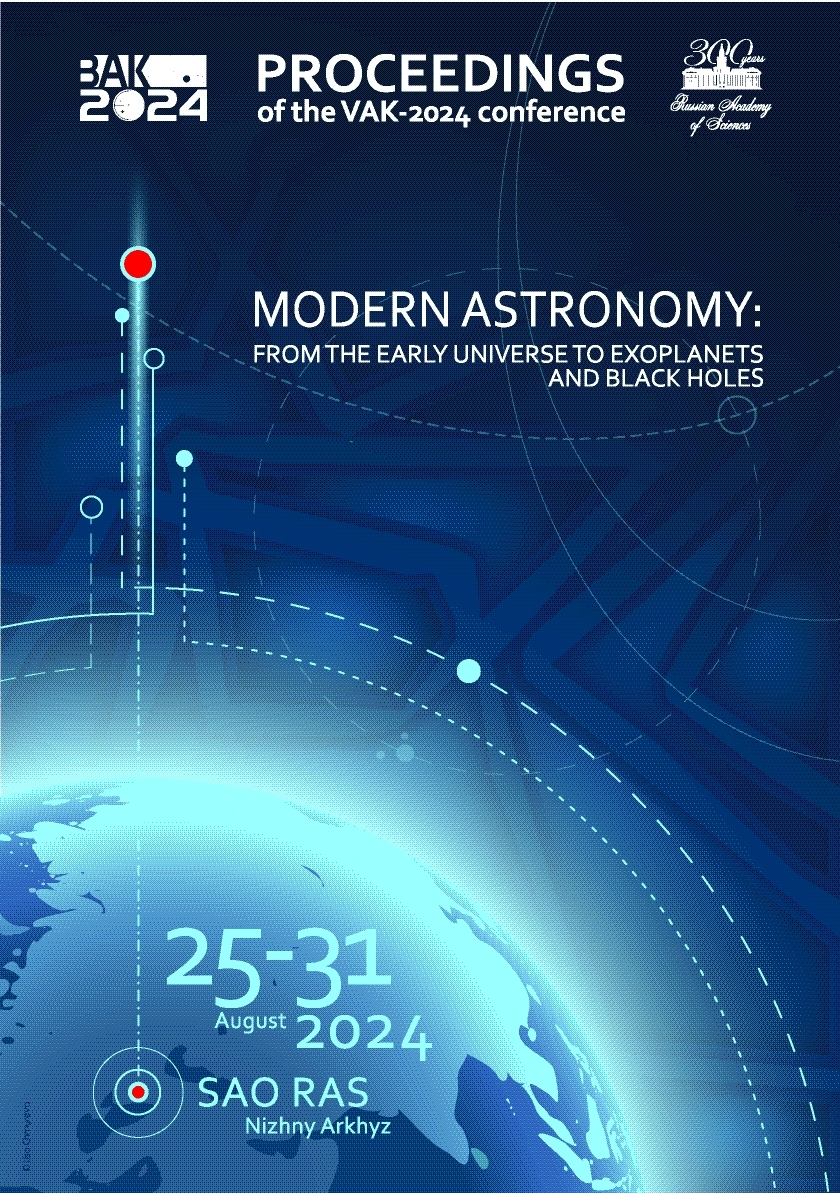Crimean Astrophysical Observatory of the Russian Academy of Sciences
UDC 524.33
UDC 53
UDC 520
UDC 521
UDC 523
UDC 524
UDC 52-1
UDC 52-6
CSCSTI 41.00
CSCSTI 29.35
CSCSTI 29.31
CSCSTI 29.33
CSCSTI 29.27
CSCSTI 29.05
Russian Classification of Professions by Education 03.06.01
Russian Classification of Professions by Education 03.05.01
Russian Classification of Professions by Education 03.04.03
Russian Library and Bibliographic Classification 2
Russian Library and Bibliographic Classification 223
Russian Trade and Bibliographic Classification 614
Russian Trade and Bibliographic Classification 6135
BISAC SCI004000 Astronomy
BISAC SCI005000 Physics / Astrophysics
To test the origin of the X-ray and optical emission from the $\gamma$ Cas-type stars, we analyzed their optical spectra obtained on the 6-m telescope BTA, the 1.25-m telescope of the Crimean station of the State Astronomical Institute (SAI, Moscow), the 2.5-m telescope SAI25 of SAI, and the photometric TESS light curves. We compare the optical variability of the $\gamma$ Cas-type stars with variations of their X-ray luminosity. An overlap between the periods of line profile variations in the spectra of $\gamma$ Cas stars and the variations in their X-ray brightness allows us to assume that a significant fraction of X-rays emits from the same place where the optical radiation comes from. The $\gamma$ Cas-type stars HD 45314, HD 45995 and NGC 6649 9 demonstrate the ultrafast X-ray brightness variations with the periods of about 50–90 seconds, which may be the rotation periods of white dwarfs components of binary systems. Thus, we can assume that at least for these stars the X-ray emission goes partly due to accretion onto rapidly rotating white dwarfs. The anomalously hard X-ray emission from the $\gamma$ Cas stars can be interpreted by assuming that the contribution of non-thermal X-ray emission is generated as a result of a reconnection of the local magnetic field lines of the Be star and its decretion disk.
stars: general, emission-line, Be; X-rays: stars
1. Afanasiev V.L. and Moiseev A.V., 2005, Astronomy Letters, 31, 3, p. 194
2. Delgado A.J. and Thomas H.-C. 1981, Astronomy & Astrophysics, 96, 1-2, p. 142
3. Dewi J.D.M., Pols O.R., Savonije G.J., et al., 2002, Monthly Notices Royal Astronomical Society, 331, 4, p. 1027
4. Gies D.R., Wang L., Klement R., 2023, Astrophysical Journal Letters, 942, 1, id. L6
5. Ikonnikova N.P., Shaposhnikov I.A., Esipov V.F., et al., 2021, Astronomy Letters, 47, 8. p. 560
6. Kholtygin A.F., Moiseeva A.V., Yakunin I.A., et al., 2021a, Geomagnetism and Aeronomy, 61, p. 923
7. Kholtygin A.F., Burlak, M.A., Tsiopa, O.A., 2021b, Astronomicheskij Tsirkulyar, 1649, p. 1
8. Kholtygin A.F., Ryspaeva E.B., Moiseeva A., et al., 2022a, The Multifaceted Universe: Theory and Observations-2022, id. 44
9. Kholtygin A.F., Moiseeva A.V., Yakunin I.A., et al., 2022b, Geomagnetism and Aeronomy, 62, p. 1136
10. Kholtygin A., Burlak M., Milanova Y., 2022c, Astronomicheskij Tsirkulyar, 1652, p. 1
11. Kholtygin A.F., Ryspaeva E.B., Yakunin I.A., et al., 2023a, INASAN Science Reports, 8, 2, p. 86
12. Kholtygin A.F., Yakunin I.A., Burlak M.A., et al., 2023b, Astrophysical Bulletin, 78, 4, p. 557
13. Laplace E., Götberg Y., de Mink S.E., et al., 2020, Astronomy & Astrophysics, 637, id. A6
14. Nazé Y., Motch C., Rauw G., et al., 2020, Monthly Notices Royal Astronomical Society, 493, 2, p. 2511
15. Nazé Y., Rauw G., Smith M.A., et al., 2022, Monthly Notices Royal Astronomical Society, 516, 3, p. 3366
16. Panchuk V.E., Chuntonov G.A., Naidenov I.D., 2014, Astrophysical Bulletin, 69, 3, p. 339
17. Pols O.R., Cote J., Waters L.B.F.M., et al., 1991, Astronomy & Astrophysics, 241, p. 419
18. Postnov K., Oskinova L., Torrejón J.M., 2017, Monthly Notices Royal Astronomical Society, 465, 1, p. L119
19. Potanin S.A., Belinski, A.A., Dodin A.V., et al., 2020, Astronomy Letters, 46, 12, p. 836
20. Rivinius T., Carciofi A.C., Martayan C. 2013, Astronomy and Astrophysics Review, 21, id. 69
21. Ruždjak,D., Božić H., Harmanec P., et al., 2009, Astronomy & Astrophysics, 506, 3, p. 1319
22. Ryspaeva E.B. and Kholtygin A.F., 2021, Open Astronomy, 30, 1, p. 132
23. Smith M.A., Lopes de Oliveira R., Motch C., 2012, Astrophysical Journal, 755, 1, id. 64
24. Smith M.A., Lopes de Oliveira R., Motch C., 2017, Monthly Notices Royal Astronomical Society, 469, 2, p. 1502
25. Smith R.K., Brickhouse N.S., Liedahl D.A. et al., 2001, Astrophysical Journal, 556, 2, p. L91







